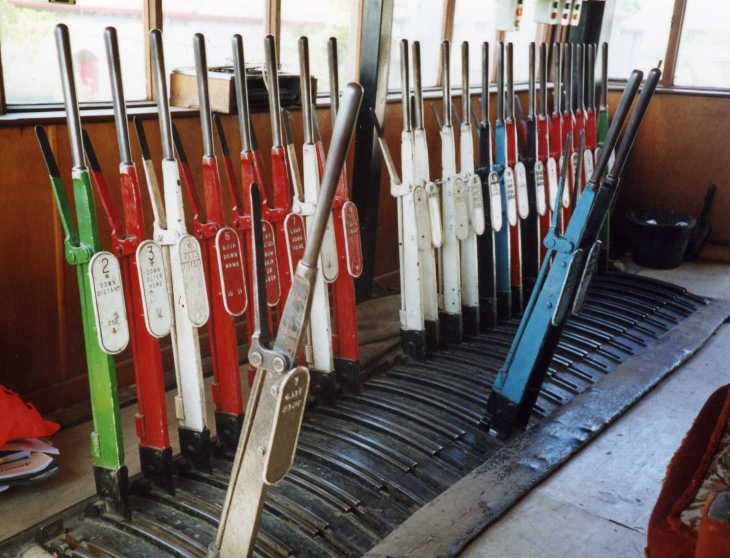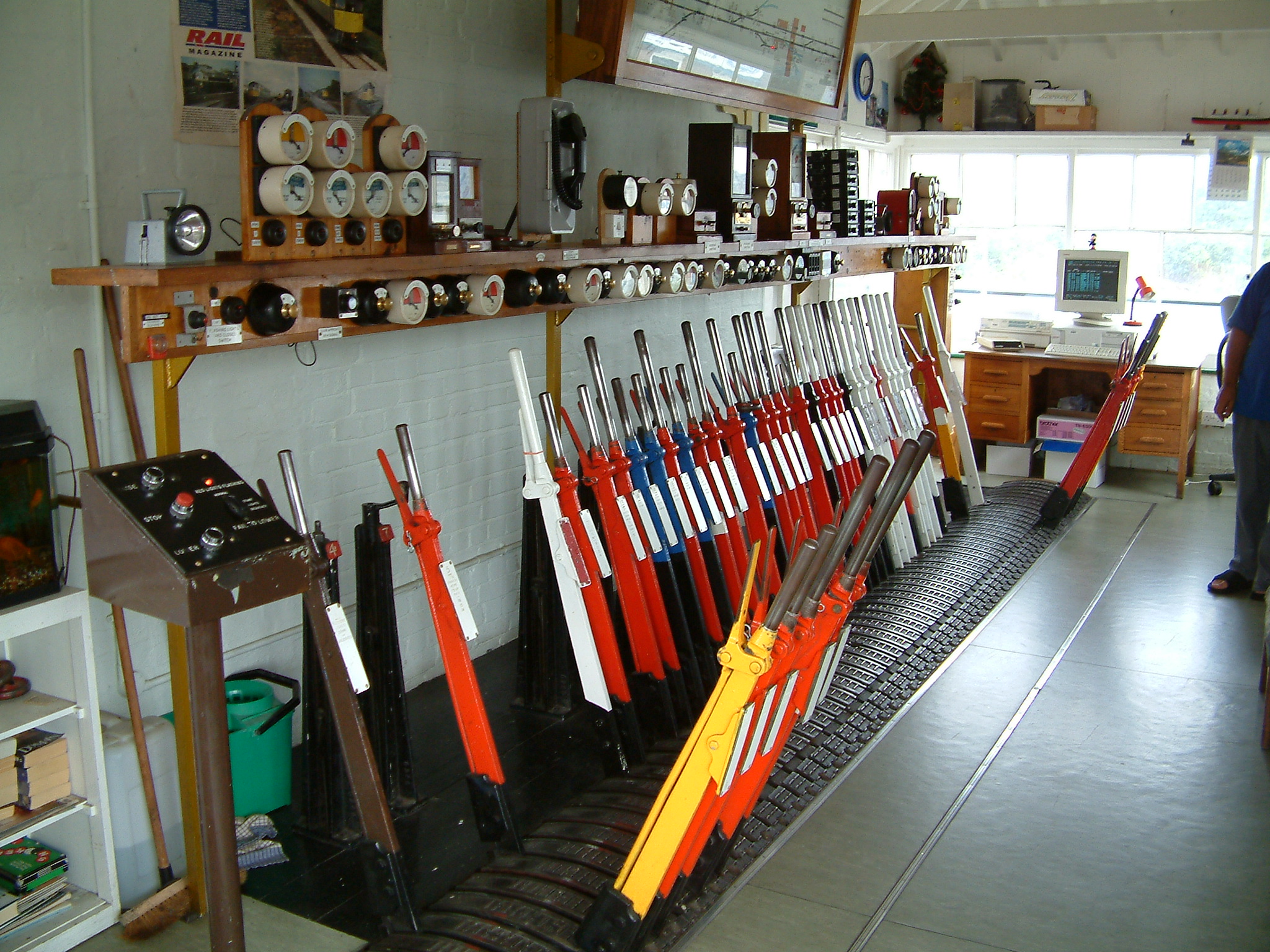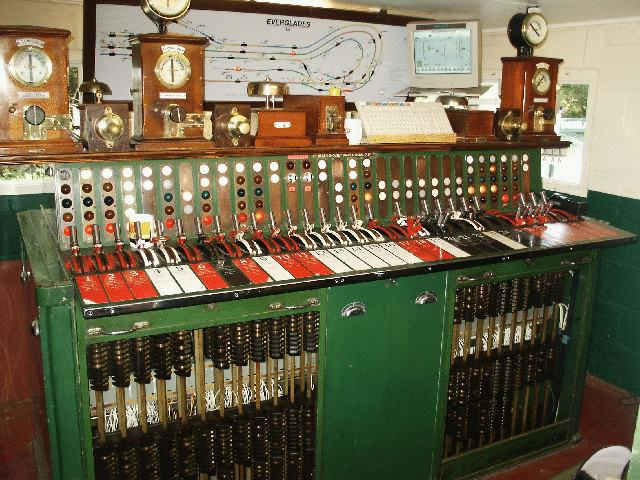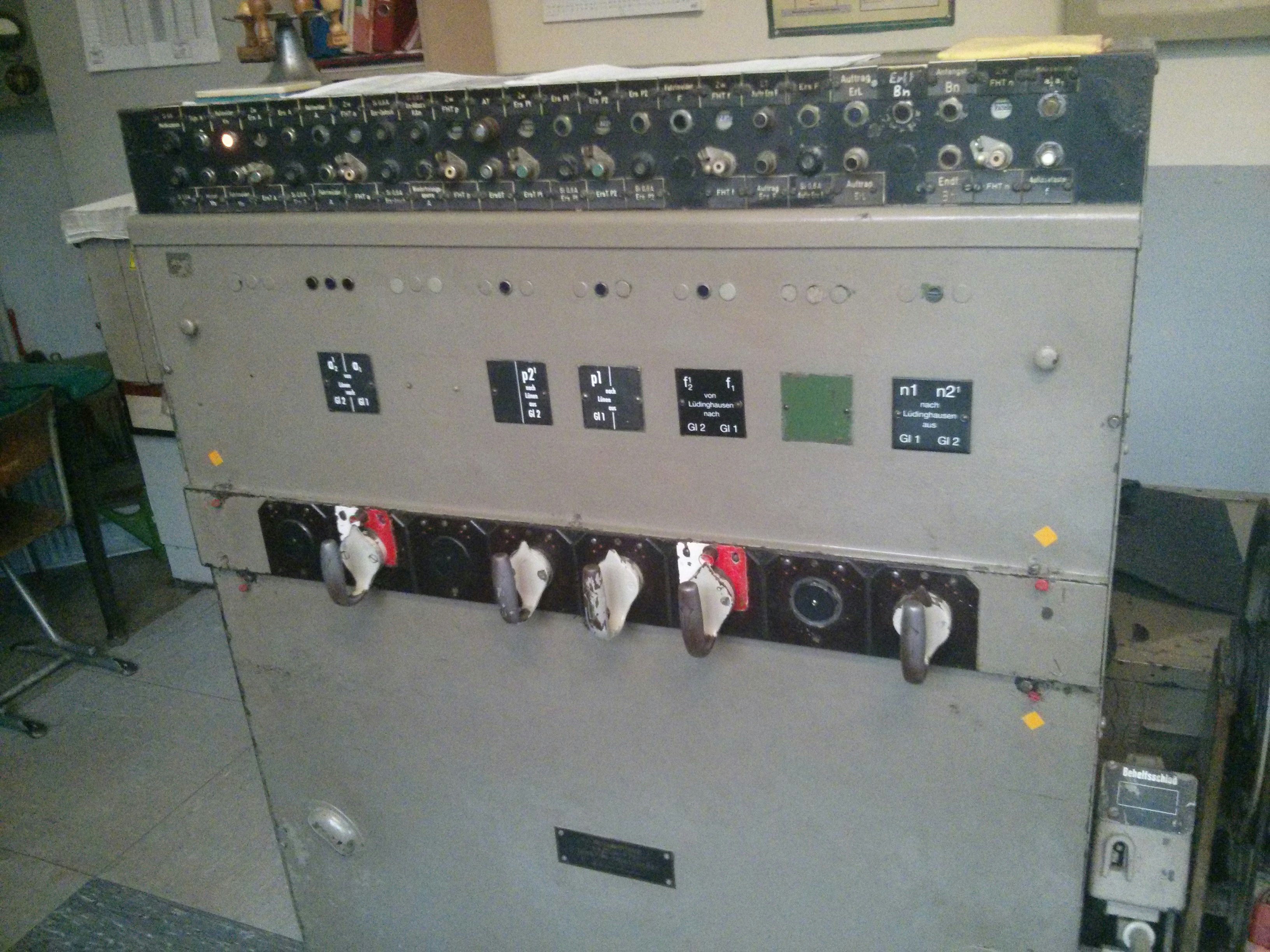Lever frame on:
[Wikipedia]
[Google]
[Amazon]
 Mechanical
Mechanical
 The lever frame is located in the signal box, which can be a building at ground level or a tower, separated from or connected to an existing station building. Early lever frames were also built as ''ground frames'' next to the track, without any form of shelter and were usually operated by traincrew and not permanently staffed. Especially in England, lever frames with the pivot underneath the floor of the signal box were common. This design's relatively short lever angle is a major disadvantage, as it requires more force to move the lever. Therefore, later, especially in Germany, lever frames with pivots inside the signaller's room were used, that allow for a lever angle of approximately 180°.
By the movement of individual levers (or sometimes cranks), signals, points, track locks,
The lever frame is located in the signal box, which can be a building at ground level or a tower, separated from or connected to an existing station building. Early lever frames were also built as ''ground frames'' next to the track, without any form of shelter and were usually operated by traincrew and not permanently staffed. Especially in England, lever frames with the pivot underneath the floor of the signal box were common. This design's relatively short lever angle is a major disadvantage, as it requires more force to move the lever. Therefore, later, especially in Germany, lever frames with pivots inside the signaller's room were used, that allow for a lever angle of approximately 180°.
By the movement of individual levers (or sometimes cranks), signals, points, track locks,

 A mechanical lever frame is designed to harness
A mechanical lever frame is designed to harness

 A power operated interlocking frame uses some form of power assist to operate switches, signals and other interlocking appliances in the field. The power can come from hydraulic, pneumatic or electric sources with direct acting or low voltage electric control. The use of mechanical levers is retained in order to engage a mechanical interlocking component, in addition to switches or valves needed to actuate the field appliances.
In hydraulic lever frames, moving the lever operates a hydraulic valve rather than wires and rods. To prevent accidents, operating a set of points requires pulling the actual lever for the points and a secondary check lever. The points are then moved by a hydraulic motor. This type of power frame has the disadvantage of a relatively low distance between points and signal box (approximately 200–250 m) and a slow operating speed. It was common in Italy and France only. Pneumatic lever frames have an operating principle that is related to that of hydraulic lever frames, however, instead of a hydraulic liquid, compressed air is used. The two types also share the same disadvantages such as pressurized tubing having to run directly between the field appliance and the lever frame. Electric control of a hydraulic or pneumatic actuator in the field was far simpler and more reliable, allowing for a greater distance between signal box and points. Whilst first being common in the United States due to work by the
A power operated interlocking frame uses some form of power assist to operate switches, signals and other interlocking appliances in the field. The power can come from hydraulic, pneumatic or electric sources with direct acting or low voltage electric control. The use of mechanical levers is retained in order to engage a mechanical interlocking component, in addition to switches or valves needed to actuate the field appliances.
In hydraulic lever frames, moving the lever operates a hydraulic valve rather than wires and rods. To prevent accidents, operating a set of points requires pulling the actual lever for the points and a secondary check lever. The points are then moved by a hydraulic motor. This type of power frame has the disadvantage of a relatively low distance between points and signal box (approximately 200–250 m) and a slow operating speed. It was common in Italy and France only. Pneumatic lever frames have an operating principle that is related to that of hydraulic lever frames, however, instead of a hydraulic liquid, compressed air is used. The two types also share the same disadvantages such as pressurized tubing having to run directly between the field appliance and the lever frame. Electric control of a hydraulic or pneumatic actuator in the field was far simpler and more reliable, allowing for a greater distance between signal box and points. Whilst first being common in the United States due to work by the
File:Signal box lever frame - geograph.org.uk - 2998668.jpg, Signal box lever frame
File:Signal box inside.jpg, Inside a signal box on the
Westinghouse Miniature Power Lever Frame web site
* Director of S&T Engineering, West Midlands Project Grou
"Mechanical Interlocking."
{{Railway signalling Railway signalling control
 Mechanical
Mechanical railway signalling
Railway signalling (), also called railroad signaling (), is a system used to control the movement of railway traffic. Trains move on fixed rails, making them uniquely susceptible to collision. This susceptibility is exacerbated by the enormou ...
installations rely on lever frames for their operation to interlock the signals
In signal processing, a signal is a function that conveys information about a phenomenon. Any quantity that can vary over space or time can be used as a signal to share messages between observers. The ''IEEE Transactions on Signal Processing'' ...
, track locks and points to allow the safe operation of trains in the area the signals control. Usually located in the signal box
In signal processing, a signal is a function that conveys information about a phenomenon. Any quantity that can vary over space or time can be used as a signal to share messages between observers. The ''IEEE Transactions on Signal Processing'' ...
, the levers are operated either by the signalman
A signalman is a person who historically made signals using flags and light. In modern times, the role of signalmen has evolved and now usually uses electronic communication equipment. Signalmen usually work in rail transport networks, armed for ...
or the pointsman.
The world's largest lever frame is believed to have been in the Spencer Street No.1 signal box in Melbourne, Australia, which had 191 levers, but was decommissioned in 2008. The largest, currently operational, lever frame is located at Severn Bridge Junction
Severn Bridge Junction is the area of railway lines just south east of Shrewsbury railway station, in Shropshire, England. It is controlled by a mechanical interlocked signal box of the same name, which is the largest operational mechanical si ...
in Shrewsbury
Shrewsbury ( , also ) is a market town, civil parish, and the county town of Shropshire, England, on the River Severn, north-west of London; at the 2021 census, it had a population of 76,782. The town's name can be pronounced as either 'Sh ...
, England, and has 180 levers; although most of them have now been taken out of use.
Overview
 The lever frame is located in the signal box, which can be a building at ground level or a tower, separated from or connected to an existing station building. Early lever frames were also built as ''ground frames'' next to the track, without any form of shelter and were usually operated by traincrew and not permanently staffed. Especially in England, lever frames with the pivot underneath the floor of the signal box were common. This design's relatively short lever angle is a major disadvantage, as it requires more force to move the lever. Therefore, later, especially in Germany, lever frames with pivots inside the signaller's room were used, that allow for a lever angle of approximately 180°.
By the movement of individual levers (or sometimes cranks), signals, points, track locks,
The lever frame is located in the signal box, which can be a building at ground level or a tower, separated from or connected to an existing station building. Early lever frames were also built as ''ground frames'' next to the track, without any form of shelter and were usually operated by traincrew and not permanently staffed. Especially in England, lever frames with the pivot underneath the floor of the signal box were common. This design's relatively short lever angle is a major disadvantage, as it requires more force to move the lever. Therefore, later, especially in Germany, lever frames with pivots inside the signaller's room were used, that allow for a lever angle of approximately 180°.
By the movement of individual levers (or sometimes cranks), signals, points, track locks, level crossing
A level crossing is an intersection where a railway line crosses a road, Trail, path, or (in rare situations) airport runway, at the same level, as opposed to the railway line crossing over or under using an Overpass#Railway, overpass ...
gates or barriers and sometimes navigable movable bridges over waterways are operated via wires and rods. The signaller chooses the correct combination of points, facing point locks and signals to operate, which will control the movement of each train through their area of control. The lever frame contains interlocking
In railway signalling, an interlocking is an arrangement of signal apparatus that prevents conflicting movements through an arrangement of tracks such as junction (rail), junctions or crossings. The signalling appliances and Track (rail transpor ...
designed to ensure that the levers cannot be operated to create a conflicting train movement. Each interlocking installation is individual and unique to the location controlled. The interlocking may be achieved mechanically or by electric lever locks, or (more usually) a combination of both.
Variants
Mechanical lever frames
 A mechanical lever frame is designed to harness
A mechanical lever frame is designed to harness mechanical advantage
Mechanical advantage is a measure of the force amplification achieved by using a tool, mechanical device or machine system. The device trades off input forces against movement to obtain a desired amplification in the output force. The model for t ...
to operate switch points, signals or both under the protection of the interlocking
In railway signalling, an interlocking is an arrangement of signal apparatus that prevents conflicting movements through an arrangement of tracks such as junction (rail), junctions or crossings. The signalling appliances and Track (rail transpor ...
logic. The levers are connected to field appliances via solid pipes or taut wires such that the full travel of the lever will reliably cause full travel in the appliance. Each lever is engaged with the interlocking logic such that movement of the lever is only possible when all necessary conditions are met. The interlocking may be mechanical, electric (via solenoid
upright=1.20, An illustration of a solenoid
upright=1.20, Magnetic field created by a seven-loop solenoid (cross-sectional view) described using field lines
A solenoid () is a type of electromagnet formed by a helix, helical coil of wire whose ...
s) or both with the apparatus being mounted horizontally behind the lever frame or vertically below it.
To assist the operator in determining their functions, each lever in a frame will generally be uniquely labelled, one common method being to number the levers in order from left to right. A lever's identification may be painted on its side or engraved on a badge or plate fitted either to the lever or behind it. This may be accompanied by a description of the lever's function. Usually, a large track diagram is positioned within easy view of the operator, which clearly shows each lever number adjacent to symbols representing the items of equipment that they operate. Levers are commonly coloured according to the type of equipment they control, the code of colours varying between different railway administrations. For example, in British practice, the following code generally applies: a red lever controls a stop signal or shunt signal, a yellow lever controls a distant signal, a black lever controls a set of points, a blue lever controls a facing point lock, and a white lever is spare. Brown levers are used to lock level crossing gates. Lever handles are usually of polished, unpainted steel, and signalmen operate them with a cloth to prevent rusting from the sweat on their hands. In Germany, signal levers are red, whilst levers for points and track locks are usually blue, and route lock levers are green. Also, individual numbers and letters are used to indicate each individual item a lever operates in Germany as well.
Some mechanical frames were combined with a set of electric levers or switches to more efficiently work electrically powered signals or other non-mechanically operated devices. Typically the switch points would be left under mechanical operation as the other devices used comparatively little electrical power and could be run off of batteries or a low capacity railroad-operated power system.
Power frames

 A power operated interlocking frame uses some form of power assist to operate switches, signals and other interlocking appliances in the field. The power can come from hydraulic, pneumatic or electric sources with direct acting or low voltage electric control. The use of mechanical levers is retained in order to engage a mechanical interlocking component, in addition to switches or valves needed to actuate the field appliances.
In hydraulic lever frames, moving the lever operates a hydraulic valve rather than wires and rods. To prevent accidents, operating a set of points requires pulling the actual lever for the points and a secondary check lever. The points are then moved by a hydraulic motor. This type of power frame has the disadvantage of a relatively low distance between points and signal box (approximately 200–250 m) and a slow operating speed. It was common in Italy and France only. Pneumatic lever frames have an operating principle that is related to that of hydraulic lever frames, however, instead of a hydraulic liquid, compressed air is used. The two types also share the same disadvantages such as pressurized tubing having to run directly between the field appliance and the lever frame. Electric control of a hydraulic or pneumatic actuator in the field was far simpler and more reliable, allowing for a greater distance between signal box and points. Whilst first being common in the United States due to work by the
A power operated interlocking frame uses some form of power assist to operate switches, signals and other interlocking appliances in the field. The power can come from hydraulic, pneumatic or electric sources with direct acting or low voltage electric control. The use of mechanical levers is retained in order to engage a mechanical interlocking component, in addition to switches or valves needed to actuate the field appliances.
In hydraulic lever frames, moving the lever operates a hydraulic valve rather than wires and rods. To prevent accidents, operating a set of points requires pulling the actual lever for the points and a secondary check lever. The points are then moved by a hydraulic motor. This type of power frame has the disadvantage of a relatively low distance between points and signal box (approximately 200–250 m) and a slow operating speed. It was common in Italy and France only. Pneumatic lever frames have an operating principle that is related to that of hydraulic lever frames, however, instead of a hydraulic liquid, compressed air is used. The two types also share the same disadvantages such as pressurized tubing having to run directly between the field appliance and the lever frame. Electric control of a hydraulic or pneumatic actuator in the field was far simpler and more reliable, allowing for a greater distance between signal box and points. Whilst first being common in the United States due to work by the Union Switch & Signal
Union Switch & Signal (commonly referred to as US&S) was an American company based in Pittsburgh, Pennsylvania, which focused on railway signaling equipment, systems and services. The company was acquired by Ansaldo STS (from 2015, Hitachi Rail ...
corporation (a division of Westinghouse Air Brake Company
The Westinghouse Air Brake Company (sometimes nicknamed or abbreviated WABCO although this was also confusingly used for spinoffs) was founded on September 28, 1869 by George Westinghouse in Pittsburgh, Pennsylvania.
Earlier in the year he had i ...
), this system was later used in the United Kingdom and other Commonwealth nations where the Westinghouse Air Brake Company had a presence.
In Austria, Siemens & Halske built a fully electric power frame in 1894, which does not rely on compressed air. Instead, electric motors move the points. Later, this system was also used in Germany. In the United States the Taylor Signal Corporation, later merged into General Railway Signal
General Railway Signal Company (GRS) was an American manufacturing company located in the Rochester, New York area. GRS was focused on railway signaling equipment, systems and services. The company was established in 1904 and became part of Alstom# ...
developed an electrically powered interlocking system that made use of mechanical slides to engage traditional mechanical locking. Union Switch and Signal later modified their electro-pneumatic system to all-electric as early as 1896.
A major issue with power frames was ensuring that the position of the levers on the frame correctly represented the position of the switch or other appliance in the field. Unlike a mechanical linkage, pneumatic or hydraulic lines could leak and cause points to drift out of correspondence with disastrous consequences. The Taylor/GRS electric power frame system used a feature called "dynamic indication" where the counter-electromotive force
Counter-electromotive force (counter EMF, CEMF, back EMF),Graf, "counterelectromotive force", Dictionary of Electronics is the electromotive force (EMF) manifesting as a voltage that opposes the change in current which induced it. CEMF is the EMF c ...
generated when the electric motor reached the limit of travel would signal the interlocking logic that the points had finished moving, but not the position of the points on an ongoing basis. This and other open loop systems designed in the 19th and early 20th centuries to save on costly relays, were replaced by closed loop systems after a number of accidents. In North America this is known as "Switch-Signal" protection and any change in the position of a field appliance will immediately set the electric signals controlled by a power frame to danger.
Since power frames still utilize traditional mechanical interlocking logic, some form of mechanical operating mechanism is still necessary. However, since the signals and points are worked by an external source of power, little mechanical effort is needed to move the levers and they could both be miniaturized and reshaped. The simplest form of power frame lever is simply a smaller version of a traditional lever. General Railway Signal was known for its "pistol grip" style levers that work slides moving in and out from a horizontal frame. Union Switch and Signal modified the Saxby & Farmer
John Saxby (17 August 1821 – 22 April 1913) was an English engineer from Brighton, noted for his work in railway signalling and the invention of the interlocking system of points and signals. He was later a partner in the firm Saxby and Farmer ...
tappet interlocking system, dispensing with the straight lever entirely and placing a rotating crank onto the locking spindle (although in the UK the Westinghouse Brake & Saxby Signal Co. modified this design to resemble a traditionally shaped miniature lever.) In continental Europe
Continental Europe or mainland Europe is the contiguous continent of Europe, excluding its surrounding islands. It can also be referred to ambiguously as the European continent, – which can conversely mean the whole of Europe – and, by ...
there were many miniature lever designs, although Siemens & Halske made use of short knobs that were rotated by the operator.
Image gallery
Isle of Wight Steam Railway
The Isle of Wight Steam Railway is a heritage railway on the Isle of Wight. The railway passes through of countryside from to station, passing through the small village of Havenstreet, where the line has a station, headquarters and a depo ...
File:Hancock-lever-frame.jpg, Mechanical lever frame in Hancock tower, US
File:Rail levers.jpg, Signal levers, Switzerland
File:Lever frame Oban Tower SRM.jpg, Oban, Saskatchewan, Canada
File:McK&H Eastgates Frame.jpg, McKenzie & Holland lever frame at Eastgates signal box, Colchester, UK
File:Cromer Beach Frame.JPG, Railway Signal Company lever frame at Cromer Beach signal box, Cromer, UK
File:Oulton Broad Swing Bridge012.JPG, View of the frame in the locking room showing how it is installed within the signal box. Oulton Broad Swing Bridge signal box, Lowestoft, UK
File:Oulton Broad Swing Bridge016.JPG, Another view in the locking room at Oulton Broad Swing Bridge, Lowestoft, UK
File:Ross's updates 044.JPG, Signal box interior, Truro, UK
File:Railway 016.jpg, Derby Road Signal box, Ipswich, UK, showing the McKenzie & Holland frame, taken in 1997. Opened in 1891 by the Great Eastern Railway
The Great Eastern Railway (GER) was a pre-grouping British railway company, whose main line linked London Liverpool Street to Norwich and which had other lines through East Anglia. The company was grouped into the London and North Eastern R ...
. Abolished and demolished in 1999
See also
*References
External links
Westinghouse Miniature Power Lever Frame web site
* Director of S&T Engineering, West Midlands Project Grou
"Mechanical Interlocking."
{{Railway signalling Railway signalling control